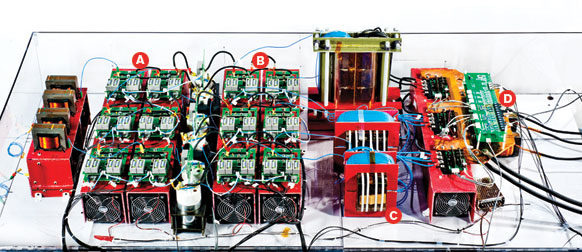Controlling the electric current in order to stabilize the network. This field is also one of the ten new technologies that will be presented tomorrow at the "Back to the Future" conference

Translated from the Technology Review
BY DAVID H. FREEDMAN
Jason Fontin, the editor of the technology magazine Technology Review from MIT, will arrive in Israel this week and participate in the Back to the Future conference of the MIT Forum on Thursday. In honor of the occasion, we have chosen to present to you the Technology review's selection of the ten world-changing technologies of 2011. One of the technologies chosen is smart transformers.
In a lab wired with electrical wires to simulate a residential neighborhood, Alex Hang is working to transform the old power grid into something more like the Internet - a network that will route energy not just from a number of centralized power plants to customers, but from any source to any destination using the most logical path. To this end, Hang, a professor of electrical engineering at the University of North Carolina, is reinventing the transformers that currently lower the voltage of the electricity routed to neighborhoods so that it is suitable for use in a home environment.
His new converter will allow the grid to handle things it wasn't originally designed for, such as charging a large number of electric vehicles and dealing with excess electricity from solar power producers. Smart electricity meters in homes and offices can help by providing information about the flow of electricity but still precise control of the flow is also necessary. The new technology will not only stabilize the electricity grid but will also create a better balance between demand and supply, thus reducing the variation in electricity consumption and making it possible to supply the electricity consumption with fewer power plants.
"We need a radically different device that will sit between the homes and the power grid and act as a buffer so that the grid remains stable regardless of what happens in the homes," says Hang. Conventional transformers handle only alternating current and require manual adjustment, or control by bulky electromechanical switches, to divert the current from one place to another. What Hang wants to create is a compact converter that can convert both direct current and alternating current, a converter whose control will be electronic so that it will respond almost immediately to fluctuations in consumption or production. For example, if a neighbor connects his electric car to an alternating current charger, the converter will be able to route electricity in favor of charging electricity from a solar panel that creates direct current that would otherwise be wasted.
To build such a converter, Hang began developing transistors and other semiconductor-based devices that could handle thousands of volts. For the benefit of the matter, he founded the companies Renewable Electric Energy Delivery and Management Systems Center in North Carolina in 2008. His first converter had silicon components but silicon is not reliable enough for large scale systems that conduct electricity at high voltages. And so Hang paved the way for the development of converters with semiconductors based on compounds of silicon, carbon, gallium and nitrogen. These compounds are more reliable when working with high voltages. He expects to produce a beta version of a carbon-silicon converter in two years and a product that will be used by power grids in five years.
Hang's converters will allow connecting an electric car or solar panel to be as simple as connecting a digital camera or printer to a computer. This will allow us to reduce our dependence on oil by simplifying the electricity grid connection to small-scale clean energy sources. Hang says "the social benefit will come when there is an aggregate effect from many small producers connecting to the electricity grid. We hope that these will be reliable and renewable sources of energy."

3 תגובות
Such smart switching will require changing the entire architecture of the electricity network. Today it is built more in the form of a tree - from the manufacturer to the multiple customers and what the electrical engineering professor wants to do is to route currents in the form of a network - and for this the network shape must be converted, while laying many new power lines.
As we saw from the stories of the last mile and the high-speed Internet connection, the infrastructure companies are really not happy about the huge investment involved, especially when the alternative (from their point of view) is to continue providing the same familiar service at an exorbitant price, and without being confused.
I wonder if it is based on fast switching itself in the DC-DC converter
Sounds genius!!!